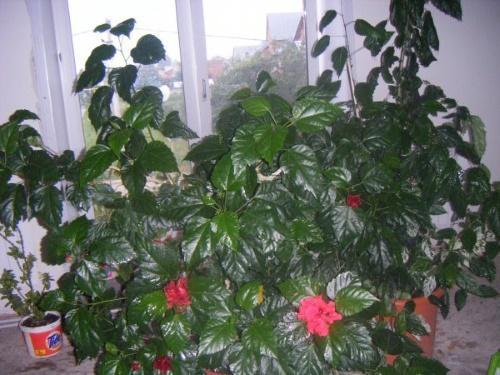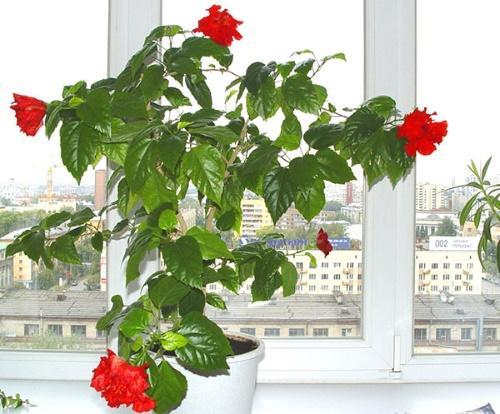How to care for a Chinese rose to bloom every year
 The Chinese rose is one of the most popular plants. It can often be found both in office premises and in apartments and private houses. Lush bushes or small trees will decorate the interior with their rich and bright foliage. And they bloom very beautifully, dissolving large inflorescences, really a bit like a garden rose. They can be plain or stuffed, and the coloration is mainly in white, red and yellow. At home, the plant feels good, but to enjoy its flowering every year, you need to know how to care for a Chinese rose. If you do everything right, the rose will turn from a small bush into a real small tree and will bloom regularly.
The Chinese rose is one of the most popular plants. It can often be found both in office premises and in apartments and private houses. Lush bushes or small trees will decorate the interior with their rich and bright foliage. And they bloom very beautifully, dissolving large inflorescences, really a bit like a garden rose. They can be plain or stuffed, and the coloration is mainly in white, red and yellow. At home, the plant feels good, but to enjoy its flowering every year, you need to know how to care for a Chinese rose. If you do everything right, the rose will turn from a small bush into a real small tree and will bloom regularly.
How to care for a Chinese rose and what to look for
The flower is also known as Chinese hibiscus and in general it is a rather unpretentious plant. It can grow with minimal care, but there are some rules to follow to see flowers. Among them:
- comfortable conditions of detention;
- suitable soil;
- correct watering;
- balanced feeding;
- timely pruning.
Temperature and lighting for hibiscus

Indoor rose loves warmth, but it can overwinter in light coolness (about 6 ° C heat). But in the summer it is best to put the pot outside under the trees - there the flower will begin to actively grow new shoots.
In terms of air humidity, hibiscus loves moisture. However, dry air is not very scary for him, especially if the leaves are often sprayed.
What kind of soil does indoor hibiscus need?
 The Chinese rose is not very demanding on the composition of the soil and can survive even in ordinary soil from the garden. But for the development to be more active, it is better that the substrate is loose and nutritious. It will be easier for the roots to grow and breathe, and moisture will not stagnate. It's a good idea to add humus - it will provide nutrients. And the sand will provide air and water circulation.
The Chinese rose is not very demanding on the composition of the soil and can survive even in ordinary soil from the garden. But for the development to be more active, it is better that the substrate is loose and nutritious. It will be easier for the roots to grow and breathe, and moisture will not stagnate. It's a good idea to add humus - it will provide nutrients. And the sand will provide air and water circulation.
How often to water?
 Watering for hibiscus is one of the important foundations of growing. Here you need to find the "golden mean", since both the bay and overdrying are undesirable for a flower. In constantly moist soil, roots begin to rot, and from a lack of moisture, wilting and leaf fall begins.
Watering for hibiscus is one of the important foundations of growing. Here you need to find the "golden mean", since both the bay and overdrying are undesirable for a flower. In constantly moist soil, roots begin to rot, and from a lack of moisture, wilting and leaf fall begins.
In summer, hibiscus is often watered, especially if it is outside. In winter, the time between waterings is increased, but the substrate cannot be allowed to dry completely.
What to feed?
 In the spring and summer period, hibiscus needs additional feeding, while choosing fertilizers should be done carefully. Although the culture is flourishing, fertilizers not all are suitable for this group of plants.Most of all, hibiscus needs potassium and magnesium, but care should be taken with nitrogen and phosphorus. From an overabundance of the first, the flower begins to "fatten" and stops blooming, and an excess of the second element reduces the quality of flowering. Top dressing is applied every 10 days.
In the spring and summer period, hibiscus needs additional feeding, while choosing fertilizers should be done carefully. Although the culture is flourishing, fertilizers not all are suitable for this group of plants.Most of all, hibiscus needs potassium and magnesium, but care should be taken with nitrogen and phosphorus. From an overabundance of the first, the flower begins to "fatten" and stops blooming, and an excess of the second element reduces the quality of flowering. Top dressing is applied every 10 days.
Siliplant will help to provide the rose with magnesium, as well as fertilizer for conifers Greenworld. And the balanced composition of potassium, phosphorus and nitrogen for this flower is contained in the universal fertilizer for potted Pocon.
When to trim?
 The Chinese rose is one of those plants that lends itself well to shaping. A regular haircut helps not only to improve the health of the bush, but also to give it a magnificent shape. At the end of winter, the shoots that have elongated over the season are shortened, both old and young. Then, after the end of flowering, you need to trim all the branches that gave the bud. In addition, thickening shoots growing inside the crown and vertically located branches are completely removed.
The Chinese rose is one of those plants that lends itself well to shaping. A regular haircut helps not only to improve the health of the bush, but also to give it a magnificent shape. At the end of winter, the shoots that have elongated over the season are shortened, both old and young. Then, after the end of flowering, you need to trim all the branches that gave the bud. In addition, thickening shoots growing inside the crown and vertically located branches are completely removed.